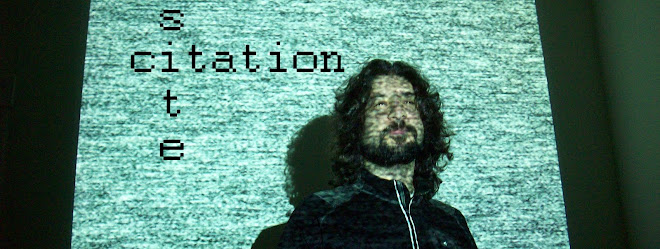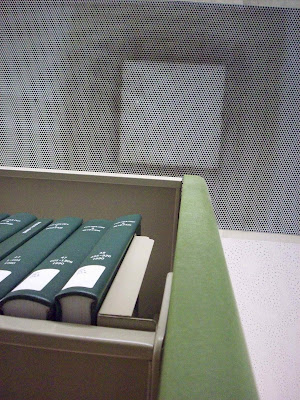

There is a commercial on Maryland Public Television that portrays a conductor sitting at his piano, hitting the keys in frustration, unable to begin writing a piece of music. He steps to the window, puts his coffee to his lips, then watches as a flock of sparrows alight upon a series of 5 electrical wires. This is when the lightbulb goes on: the theme, so to speak, is created by the random landing pattern of the birds. The conductor rushes to the piano, then begins to play an absurdly dense piece of music in the post-classical stylings of Scelsi or Feldman. The simplicity of the non-interventionist act of composition-by the birds-leads the composer to hear the music in the environment. As I suggest further, this active listening (and seeing, as in the composer's case) creates an individualized experience. But, because sound belongs to no one in particular (except, perhaps, the attentive listener), the plurality of music is made real.
If only life presented us with such moments of eureka. Instead, as in my case, life lends an overdose of traffic noise. But, like the conductor at the piano (as superficial as he may be-it is a commercial after all) I take what the environment gives me, and balance the elements to create a composition that begs listening for, and understanding, the relationships between all the sounds.
Granted, I edit as much as possible so as not to overwhelm the ears, but I do succumb to the pressures of highlighting a certain aspect of a recording at times, editing out unwanted noise or feedback. Today's venture, capturing an orgy of unidentified birds in the trees flanking the alley, is one of those recordings that I acted on to highlight individual sounds. Why? Because the cacophony was so great (the birds numbered in the dozens) and the traffic so dense (it was morning rush-hour) that leaving the recording in its virgin state would have amounted to a flat and uninteresting waste of airtime.
This leads me back, as always, to audio integrity. Where is the line that separates truth in listening and edit-filtration? When I talked to
Jeph Jerman last week, I addressed the same problem, and rendered an answer that is obvious in its complexity: just as an stereo speaker synthesizes an electrical impulse into audio, so do our ears synthesize vibrations of air. This synthesis is reframed by the brain as sound. So, in some respect, we never hear the vibrations-only the synthesis.
So, this fine line? It doesn't exist. Is there more fiction in a processed recording? Perhaps to some degree, but not absolutely. The child who wears a hearing aid and listens to a synthesis of impulses from vibrations in the air is no more handicapped or priviledged than the normal hearer. And this is where we get into trouble, assigning the status of normality and abnormality to listeners.
Ultimately, and at this point I wish to emphasize Jeph's concerns because they mirror mine, what this project boils down to, what I advocate for more than anything else, is not purity of sound, because that assumes a priviledging of point of view. What I stress is that one simply listen, "really listen," as Jeph puts it. I don't go into the field to capture pristine environments, but do it because I want to make explicit the act of listening, transpose the passive act into the active, because listening is an activity. I merely point in the direction of sound, and make no judgments about it. I advocate for listening without prejudice.
What is it to listen? If one could go into the field, without device, with just their ears, and listen, then, as one listens actively, one composes an environment actively. Yes, compose. No need for us to write things on paper and reproduce them-if we listen attentively, we can coordinate sounds that are already present. This is non-intervention, the purest form of music.
And because our biases automatically filter what surrounds us, the environment creates a different exeperience for each individual. This is, in fact, a pluralistic music, one that cannot be recorded and played back.


















































